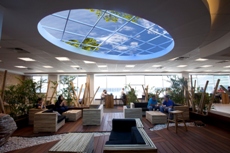
Workers in many studies have reported feeling less stressed and more satisfied when they work in environments with access to nature or goodly amount of greenery. Adding plants to your office design is a good start, but the next level is coming, and hopefully to an office near you: biophilic design.
Biophilic design does more than bring in a lot of pretty pictures or plants: It seeks to mimic the forms of nature and provide context in the form of lighting, depth of field in imagery, and other visual cues that allow the mind to perceive a natural setting. And the evidence for the benefits of this design ethos is growing.
The well-known Sir Cary Cooper is professor of organisational psychology at the University of Manchester and led the Global Impact of Biophilic Design in the Workplace study, published in 2015, that found those “who worked in environments with natural elements” reported a 15% higher level of well-being, a 6% higher level of productivity and a 15% higher level of creativity”. The survey was done in conjunction with Human Spaces, which studies and promotes research into human and nature interaction, primarily in the workplace; with 7,600 respondents in 16 countries, the report offered the first large-scale, international data set on the benefits on biophilic design.
Among other key findings of the report:
- Those entering an office which incorporates nature “are more likely to feel happy and motivated for the day ahead.”
- 33 percent of respondents report that the design of an office would affect their decision to work for that organization.
- A survey of existing literature suggests that nature contact has a restorative effect on people, helping them deal with day-to-day stress and work to maintain performance.
- 47 percent report having no natural light and 58 percent report having no live plants.
This last point is rather shocking for how high those numbers are. They really drive home at least one of the reasons for work-related stress as a global urban phenomenon. Sir Cooper introduces the report with these words: “This new research report is an important and practical piece, showcasing for the first time the universal connectivity of humans with their natural and built environments. As well as enabling organizations to make links between their physical spaces and the performance of their people, this study throws light on some of the cultural differences at work across the world, and offers an answer to one of the defining factors of modern life – our ability to cope with urbanization and loss of connection with green spaces.”
What’s a Business to Do?
While the likes of Google and Amazon can well afford multi-story living walls and areas for their people, the vast majority of small and medium-size businesses are constrained by leased space that is only getting more expensive. The good news is that decor, lighting, and fit out offer many options for creating a space that employees and the business will benefit from.
According to the report, the top five things office workers around the world want are: natural light (44 percent), plants (20 percent), quiet spaces (19 percent), a view of the sea (17 percent), and bright colours (15 percent).
OK, we’d all love a view of the ocean, but few companies can fix that problem. On the other hand, plants, paint, and accessories are the easiest things in the world for a company to provide.
Lighting is another huge factor: If we’ve learned anything over the past 50 years, it’s that humans don’t like spending all their time under ugly fluorescent lights. If your space isn’t easily adapted for day lighting, work with a design consultant on light-cover treatments and bulb colours to illuminate workspaces. The data show that it contributes to lower mental health and poor sleep.
A consultant can also help you see the possibilities for making changes that allow more light to flow through from windows – for instance, if the walls are lined with offices that have solid doors or shades up, this is blocking the flow for everyone who isn’t in an office (which is to say, the majority of workers nowadays). What design and setup tweaks can be made to increase that flow?
Good for Business, Good for People
Talk about a win-win. Applying the principles of biophilic design has the power to transform a business by motivating the people who work there and lowering their stress. There might not be a lot you as an owner feel you can do to keep the bottom line up and costs down, but your money will be well spent on improving the office environment for all.






